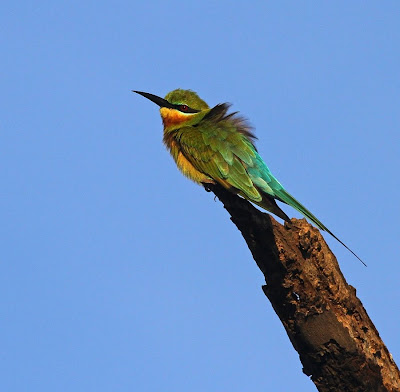Pulau Burung is a peculiar paradox of a place. It's a stinking landfill site, one of the most noxious places you could imagine to visit, yet the light there first thing in the morning is unlike anywhere else I know, and this, coupled with an abundance of confiding birds, makes it a great place for photography, even in the absence of the phalarope!



White-browed Crake, Wood Sandpiper and Little Grebe at first light.

A Wood Sandpiper at point blank range, resized but uncropped.

A Lesser Whistling-duck taking a bath at sunrise.

Water off a duck's back!


A subadult Little Grebe.




This Blue-tailed Bee-eater was begging to be photographed. I was happy to oblige!

A Wood (left) and Common Sandpiper pose for handy comparison!

A slightly closer Common Sandpiper.

A Crested Serpent-eagle enjoying the sun.
Since the phalarope was clearly elsewhere, I decided to drive over to Kampung Permatang Nibong in search of recently-arrived aquila eagles.


The first birds I came across were two Slaty-breasted Rails, though the light could have been better!

It wasn't long before the first Aquila was discovered - a cracking adult or near adult Eastern Imperial!

Being mobbed by a most upset Black-shouldered Kite.

Frustratingly, the eagle flew off before I could get any closer views.

This subadult Greater Spotted Eagle was much more obliging.



The bird appeared to be panting (it was hot!!)

While watching it, we realized that it had been joined by a second Greater Spotted, a younger bird, judging by the pale trailing edge to the wing.

Here's the first bird again.

The Eastern Imperial flew overhead briefly, providing a nice shape comparison.

Neither of which should be confused with the much commoner and smaller Black-eared Kite.

While Terence and I tried to approach the Eastern Imperial again, we came across this nice female Eastern Stonechat - a scarce bird in the non-breeding season, and always a nice find.

Paying attention to the wagtails in the paddyfields paid off - still no Citrine, but Red-throated Pipits - at least four of them.

Oddly, we didn't hear them call once, even when they flew. Usually Red-throated Pipits are pretty vocal, and the call is one of the easiest ways to pick them up.

Helpfully showing off the rump, which is streaked (though barely!).

We thought this plainer, more worn bird was probably an adult winter, whereas the other brighter, fresher birds were first winters.


Showing off!

The stripey plumage blended in surprising well with the dead paddy stalks.

While we were watching the pipits a Pale/Sand Martin made several fly-pasts.
By this time the remnants of my cold were beginning to make themselves felt, so I reluctantly decided to call it a day. However,on my way back I bumped into ...


... the Ruff flock at last! Well - five of them anyway (there were originally six). I counted 3 males and 2 females.

In just three weeks since there were photographed on 25 October, they have almost completed their body moult into first winter plumage. You can still see a few juvenile lesser coverts, scapulars and mantle feathers on the female (left).

The difference in size between the male (left) and female is very obvious here.

And here!

The white U shape on the rump is unique to Ruff.

Three males and a female.
A couple of shots from an abortive trip two days ago, when my car broke down!

Black-browed Reed Warbler.

Oriental Reed Warbler.
So that's it for now. Off to Australia for a month on Thursday. Please don't find too many rarities while I'm gone folks!
5 comments:
Great work at Permatang Nibong. Have a good one in Australia. I can't make any promises about the rarities though!
What a collection! Beautiful series!
ooo.. Awesome write up and photos. Have a great trip to Australia. Cheerio~~
Enjoy Australia, David. If you're not distracted by the Ashes series you must see some great birds...
Dave, finally got that Imperial under the belt, nice adult on the pylons, will have to compare photos though, as mine appears to be a different bird to yours. Also 3 GSE, including your 2 photographed birds...
Post a Comment